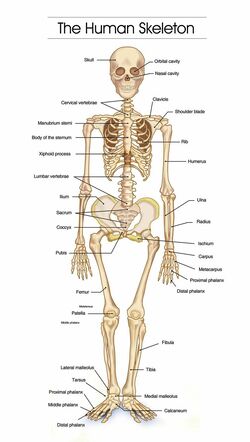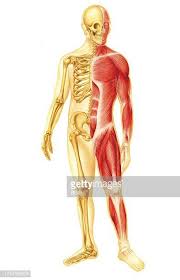
The Skeletal System
Bones protect, give structure and movement and produce blood cells in the bone morrow.
There are two categories of bones. Axial bones keep you upright. Appendicular bones give you movement.
The bone in the skull is called the cranium. It is for protecting the brain and also is a large bone forming the structure of the face.
The ribcage is used to protect the lungs, liver and heart. The ribs are in pairs, they are connected to the vertebrae and the ribcage although the ones at the bottom float, they are only connected to the vertebrae. Arms and legs are very similar in structure, they both have three bones. The three bones in the arm are called ulna, radius and humerus and in legs femur, fibula and tibia. The femur is the largest bone in your body.
Joints keep your bones together, joints are very small. Ball and socket has full circulation in your arms and legs. Hinge joints can move in two ways up and down example: elbow and knee.
You can keep your body strong by drinking milk eating healthy and staying fit.
Bones protect, give structure and movement and produce blood cells in the bone morrow.
There are two categories of bones. Axial bones keep you upright. Appendicular bones give you movement.
The bone in the skull is called the cranium. It is for protecting the brain and also is a large bone forming the structure of the face.
The ribcage is used to protect the lungs, liver and heart. The ribs are in pairs, they are connected to the vertebrae and the ribcage although the ones at the bottom float, they are only connected to the vertebrae. Arms and legs are very similar in structure, they both have three bones. The three bones in the arm are called ulna, radius and humerus and in legs femur, fibula and tibia. The femur is the largest bone in your body.
Joints keep your bones together, joints are very small. Ball and socket has full circulation in your arms and legs. Hinge joints can move in two ways up and down example: elbow and knee.
You can keep your body strong by drinking milk eating healthy and staying fit.


 RSS Feed
RSS Feed